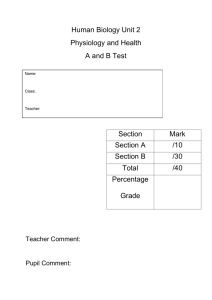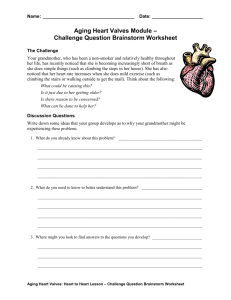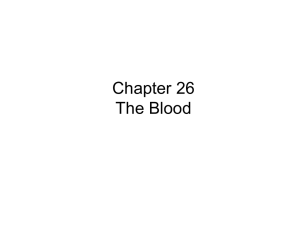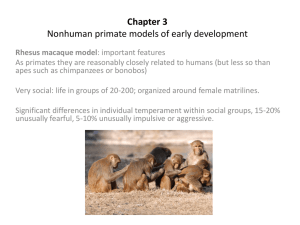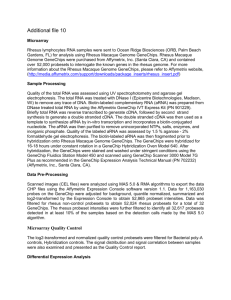Human Biology Unit 2 - Kinross High School
advertisement
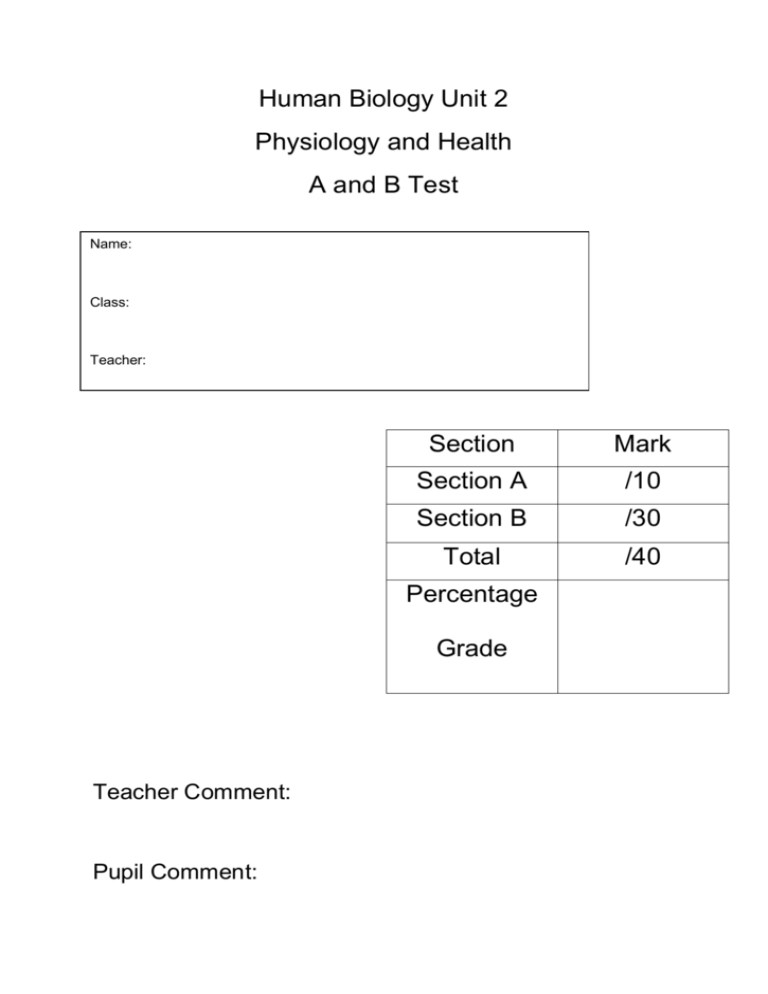
Human Biology Unit 2 Physiology and Health A and B Test Name: Class: Teacher: Section Mark Section A /10 Section B /30 Total /40 Percentage Grade Teacher Comment: Pupil Comment: Section A 1. The graph below shows the growth, in length, of a human foetus. What is the percentage increase in length of the foetus during the final four months of pregnancy? A B C D 33·3% 60·0% 62·5% 150·0% 400-250 = 150 150/250 x 100 =60% 2. The diagram below shows a cross-section of the heart. Which of the following statements describes the movement of the valves during ventricular systole? A B C D Valves P and Q open and valves R and S close Valves P and R open and valves Q and S close Valves P and Q close and valves R and S open Valves P and R close and valves Q and S open 3. Changes in the ovary during the menstrual cycle are described below. 1 Corpus luteum forms 2 Ovulation occurs 3 Progesterone is produced 4 Corpus luteum degenerates 5 Graafian follicle develops The sequence in which these changes occur following menstruation is A B C D 2, 3, 1, 5, 4 2, 1, 3, 4, 5 5, 3, 2, 1, 4 5, 2, 1, 3, 4. 4. Which of the following statements about lipoprotein is correct? A LDL transports cholesterol from body cells to heart B LDL transports cholesterol from body cells to liver C HDL transports cholesterol from body cells to heart D HDL transports cholesterol from body cells to liver 5. Chronic elevation of blood glucose levels is not responsible for which of the following conditions? A Renal failure B Retinal damage C Phenylketonuria D Peripheral nerve dysfunction 6. A function of the interstitial cells in the testes is to produce A sperm B testosterone C seminal fluid D follicle stimulating hormone (FSH) 7. Which of these cross sections through a blood vessel represents a vein? 8. Cardiac output is calculated using the following formula: Cardiac Output = Heart Rate X Stroke Volume The table below shows the heart rate and cardiac output of four individuals. Stroke volume = cardiac output/ HR = 5.8/60 = 0.97 for A Do the same calculation for all. Which individual has the greatest stroke volume? 9. Which of the following may need to receive anti-Rhesus antibodies? A A Rhesus positive mother after the birth of her Rhesus negative baby B A Rhesus positive mother after the birth of her Rhesus positive baby C A Rhesus negative mother after the birth of her Rhesus negative baby D A Rhesus negative mother after the birth of her Rhesus positive baby 10. Phenylketonuria is caused by a single autosomal gene. A man and a woman, who are unaffected, have an affected child. What is the probability that their next child will be affected? A 25% B 50% C 75% D 100% Section B 1. The graph below shows the concentration of two ovarian hormones in a woman’s blood during her menstrual cycle. (a) Name hormone X. Progesterone ____________________________________________ (1) (b) What effect does oestrogen have on the following structures? (i) The uterus between days 4 and 12 in the cycle. Oestrogen stimulates the proliferation/ development of the endometrium. ____________________________________________________________ __________________________________________________________ (1) (ii) The pituitary gland on day 12 of the cycle. Oestrogen is stimulating the pituitary gland to release LH. ____________________________________________________________ ___________________________________________________________ (1) (c) Describe one way in which the graph would be different if the woman became pregnant during this cycle. Progesterone/ Hormone X would remain high. _______________________________________________________________ _____________________________________________________________ (1) 2. Duchenne’s muscular dystrophy is an inherited condition in which muscle fibres gradually degenerate. The condition is sex-linked and caused by a recessive allele. The family tree below shows the inheritance of the condition through three generations of a family. (a) (i) Using the symbols D and d, to represent the alleles, state the genotypes of individuals R and S. XDXd XDY R _____________________________ S _________________________ (1) (ii) What percentage of the grandsons have muscular dystrophy? 1 out of 3 grandsons = 33.3% ___________________________ (1) (iii) Sisters T and U each go on to have a son. For each sister, state the percentage chance of her son having muscular dystrophy. 0% 50% Son of T _____________________ Son of U ____________________ (1) (b) Where conditions such as Duchenne’s muscular dystrophy exist in a family, the family history can be used to determine the genotypes of its individual members. What term is used for this process? Genetic Screening/ Genetic Counselling/ Pedigree chart analysis _____________________________________________________________ (1) 3. The graph below shows changes in the volume of blood in the left ventricle of a man’s heart. (a) How long does ventricular systole last? From 0.6 to 0.9 = 0.3 __________________ s (1) (b) (i) What is the heart rate of this man? 60/0.8 = 75 _____________________ beats per minute (1) (ii) Calculate the volume of blood leaving this man’s left ventricle every minute. Space for calculation 60 to 130cm3 = 70cm3 per beat. 70 x 75bpm = 5250cm3 _____________________ cm3 (1) (c) When this man exercises, the volume of blood leaving his heart increases significantly. Describe how the nervous system and hormones cause this increase. (3) 4. The diagram below represents a section through an artery. (a) Describe how the presence of muscle tissue in the artery wall helps to control the flow of blood around the body. (1) (b) Describe how an atheroma forming under layer X may lead to the formation of a blood clot and state the possible effects of this. Space for answer (5) 5. The graph below shoes changes in blood glucose concentration in a diabetic and a non-diabetic individual after each had consumed a glucose drink. (a) (i) Choose one individual, A or B and indicate whether the individual is diabetic or non-diabetic. (1) (ii) Using data from the graph, describe the changes that occurred in the blood glucose concentration of individual A after consuming the glucose drink. (2) (b) Describe the role of insulin in the development of type 1 diabetes. (1) 6. Rising levels of obesity are a major concern in modern Scottish society. Successive governments have tried to promote healthy eating and exercise in an attempt to address this problem. (a) (i) One measure of obesity is the body mass index (BMI). What measurements are taken to calculate BMI? Height and weight/mass __________________________________________________________ (1) (ii) What is the minimum value of BMI that is generally used to indicate that an individual is obese? 30 ________________________________________________________ (1) (b) Why should the dietary intake of carbohydrate in the form of free sugar be limited? (1) No energy is required for their digestion. (c) Describe how exercise reduces the risk of an individual becoming obese. (1) (d) State two ways that exercise reduces the risk factors for cardiovascular disease (CVD). 1 _____________________________________________________ 2 _____________________________________________________ (1)
